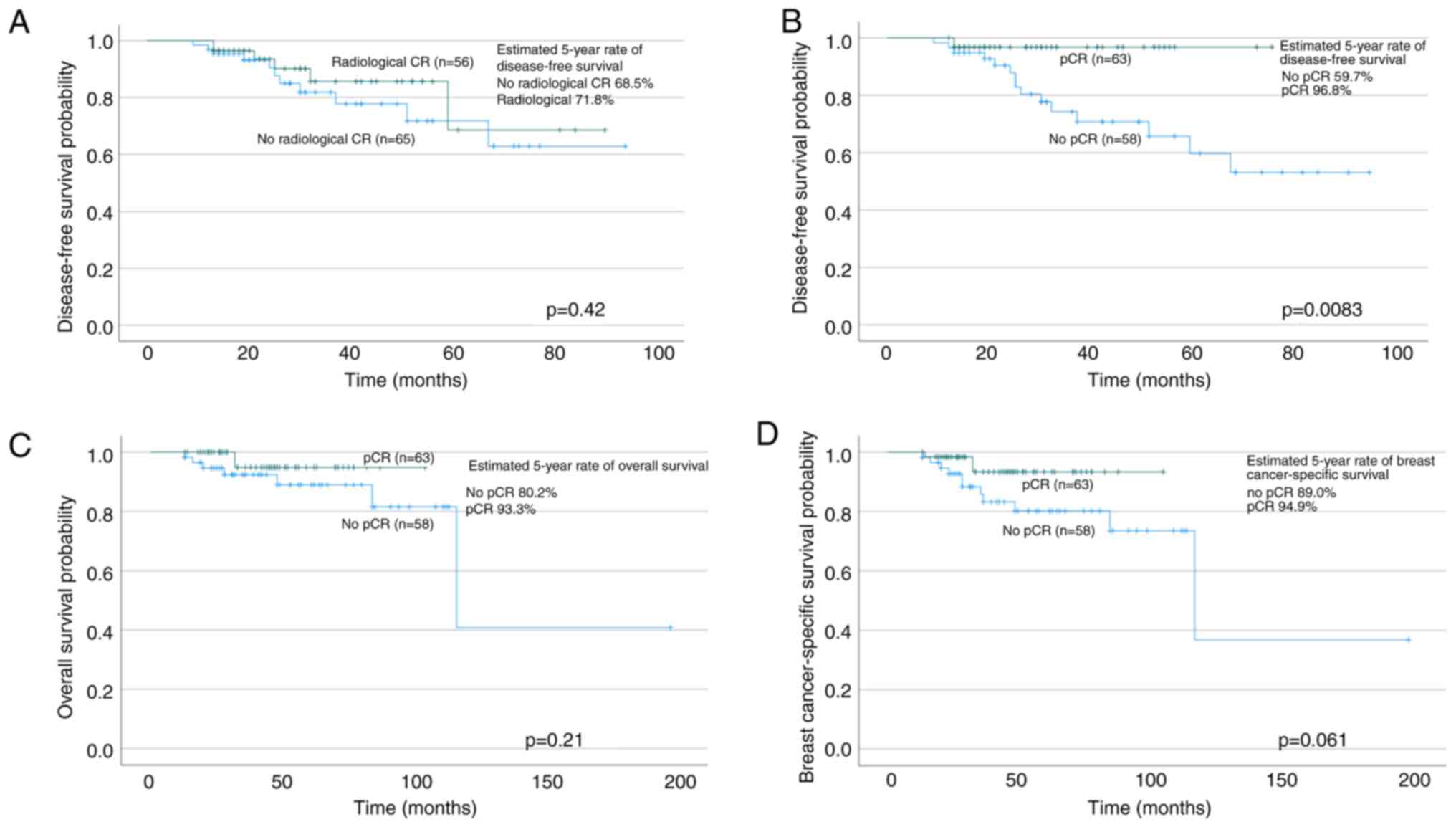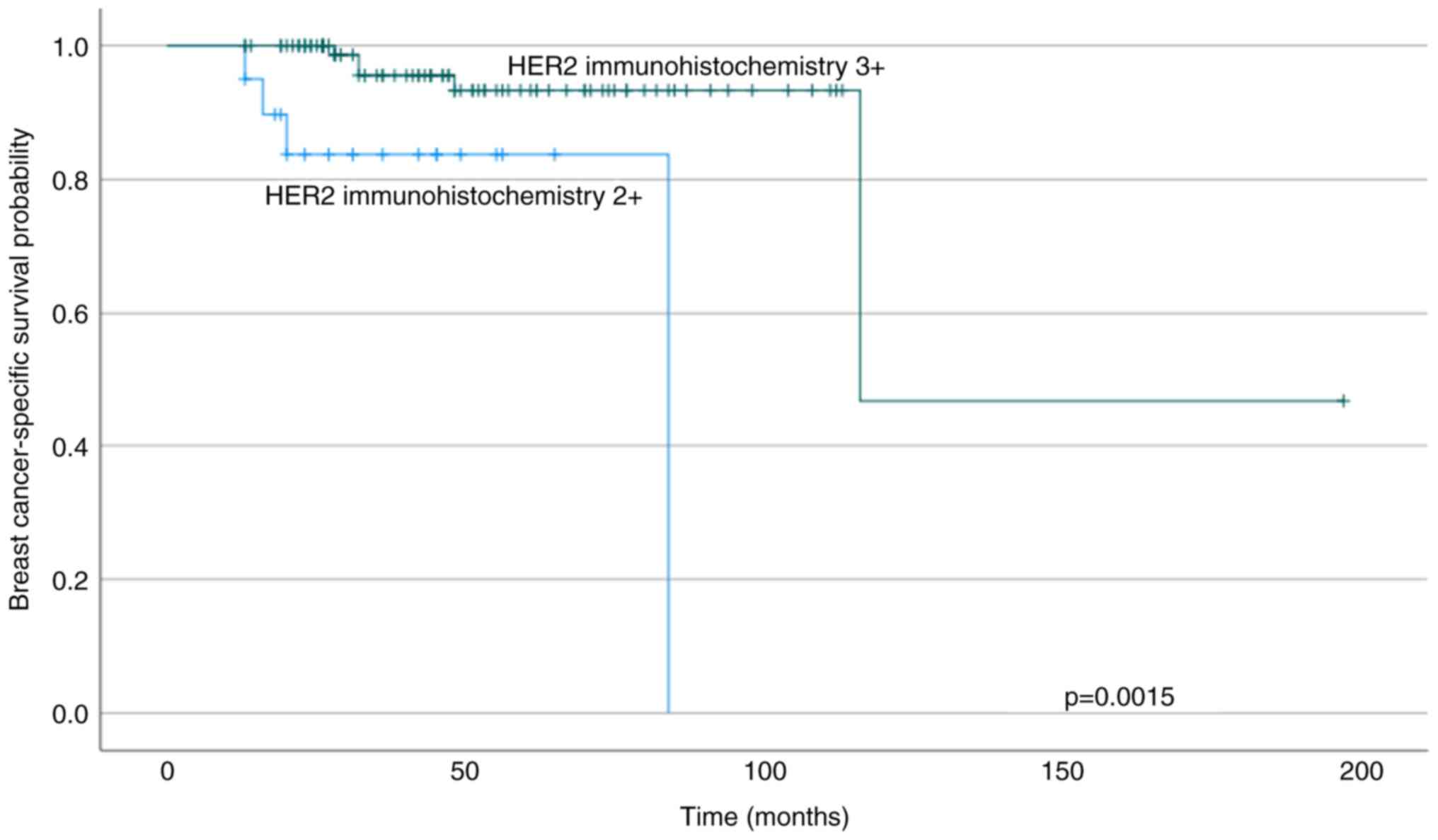|
1
|
Loibl S, Poortmans P, Morrow M, Denkert C
and Curigliano G: Breast cancer. Lancet. 397:1750–1769. 2021.
View Article : Google Scholar : PubMed/NCBI
|
|
2
|
Cortazar P, Zhang L, Untch M, Mehta K,
Costantino JP, Wolmark N, Bonnefoi H, Cameron D, Gianni L,
Valagussa P, et al: Articles Pathological complete response and
long-term clinical benefit in breast cancer: The CTNeoBC pooled
analysis. Lancet. 384:164–172. 2014. View Article : Google Scholar : PubMed/NCBI
|
|
3
|
Davey MG, Browne F, Miller N, Lowery AJ
and Kerin MJ: Pathological complete response as a surrogate to
improved survival in human epidermal growth factor
receptor-2-positive breast cancer: Systematic review and
meta-analysis. BJS Open. 6:zrac0282022. View Article : Google Scholar : PubMed/NCBI
|
|
4
|
Liu H, Lv L, Gao H and Cheng M: Pathologic
complete response and its impact on breast cancer recurrence and
patient's survival after neoadjuvant therapy: A comprehensive
meta-analysis. Comput Math Methods Med. 2021:75450912021.
View Article : Google Scholar : PubMed/NCBI
|
|
5
|
Harbeck N: Neoadjuvant and adjuvant
treatment of patients with HER2-positive early breast cancer.
Breast. 62 (Suppl 1):S12–S16. 2022. View Article : Google Scholar : PubMed/NCBI
|
|
6
|
Broglio KR, Quintana M, Foster M, Olinger
M, McGlothlin A, Berry SM, Boileau JF, Brezden-Masley C, Chia S,
Dent S, et al: Association of pathologic complete response to
neoadjuvant therapy in HER2-Positive breast cancer with long-term
outcomes: A meta-analysis. JAMA Oncol. 2:751–760. 2016. View Article : Google Scholar : PubMed/NCBI
|
|
7
|
von Minckwitz G, Huang CS, Mano MS, Loibl
S, Mamounas EP, Untch M, Wolmark N, Rastogi P, Schneeweiss A,
Redondo A, et al: Trastuzumab emtansine for residual invasive
HER2-Positive breast cancer. N Engl J Med. 380:617–628. 2019.
View Article : Google Scholar : PubMed/NCBI
|
|
8
|
Pathak M, Dwivedi SN, Deo SVS, Thakur B,
Sreenivas V and Rath GK: Effectiveness of added targeted therapies
to neoadjuvant chemotherapy for breast cancer: A systematic review
and meta-analysis. Clin Breast Cancer. 19:e690–e700. 2019.
View Article : Google Scholar : PubMed/NCBI
|
|
9
|
Bria E, Carbognin L, Furlanetto J, Pilotto
S, Bonomi M, Guarneri V, Vicentini C, Brunelli M, Nortilli R,
Pellini F, et al: Impact of neoadjuvant single or dual HER2
inhibition and chemotherapy backbone upon pathological complete
response in operable and locally advanced breast cancer:
Sensitivity analysis of randomized trials. Cancer Treat Rev.
40:847–856. 2014. View Article : Google Scholar : PubMed/NCBI
|
|
10
|
Nakashoji A, Hayashida T, Yokoe T, Maeda
H, Toyota T, Kikuchi M, Watanuki R, Nagayama A, Seki T, Takahashi
M, et al: The updated network meta-analysis of neoadjuvant therapy
for HER2-positive breast cancer. Cancer Treat Rev. 62:9–17. 2018.
View Article : Google Scholar : PubMed/NCBI
|
|
11
|
Wolff AC, Hammond MEH, Allison KH, Harvey
BE, Mangu PB, Bartlett JMS, Bilous M, Ellis IO, Fitzgibbons P,
Hanna W, et al: Human epidermal growth factor receptor 2 testing in
breast cancer: American society of clinical oncology/college of
American pathologists clinical practice guideline focused update.
Arch Pathol Lab Med. 142:1364–1382. 2018. View Article : Google Scholar : PubMed/NCBI
|
|
12
|
Takada M, Ishiguro H, Nagai S, Ohtani S,
Kawabata H, Yanagita Y, Hozumi Y, Shimizu C, Takao S, Sato N, et
al: Survival of HER2-positive primary breast cancer patients
treated by neoadjuvant chemotherapy plus trastuzumab: A multicenter
retrospective observational study (JBCRG-C03 study). Breast Cancer
Res Treat. 145:143–153. 2014. View Article : Google Scholar : PubMed/NCBI
|
|
13
|
von Minckwitz G, Untch M, Nüesch E, Loibl
S, Kaufmann M, Kümmel S, Fasching PA, Eiermann W, Blohmer JU, Costa
SD, et al: Impact of treatment characteristics on response of
different breast cancer phenotypes: Pooled analysis of the German
neo-adjuvant chemotherapy trials. Breast Cancer Res Treat.
125:145–156. 2011. View Article : Google Scholar : PubMed/NCBI
|
|
14
|
Santamaría G, Bargalló X, Fernández PL,
Farrús B, Caparrós X and Velasco M: Neoadjuvant systemic therapy in
breast cancer: Association of Contrast-enhanced MR imaging
findings, diffusion-weighted imaging findings, and tumor subtype
with tumor response. Radiology. 283:663–672. 2017. View Article : Google Scholar : PubMed/NCBI
|
|
15
|
Mukhtar RA, Yau C, Rosen M, Tandon VJ and
Hylton N: I-SPY 1 TRIAL and ACRIN 6657 Investigators; Hylton N and
Esserman LJ: Clinically meaningful tumor reduction rates vary by
prechemotherapy MRI phenotype and tumor subtype in the I-SPY 1
tRIAL (CALGB 150007/150012; ACRIN 6657). Ann Surg Oncol.
20:3828–3830. 2013. View Article : Google Scholar
|
|
16
|
van Ramshorst MS, Loo CE, Groen EJ,
Winter-Warnars GH, Wesseling J, van Duijnhoven F, Peeters MTV and
Sonke GS: MRI predicts pathologic complete response in
HER2-positive breast cancer after neoadjuvant chemotherapy. Breast
Cancer Res Treat. 164:99–106. 2017. View Article : Google Scholar : PubMed/NCBI
|
|
17
|
De Los Santos JF, Cantor A, Amos KD,
Forero A, Golshan M, Horton JK, Hudis CA, Hylton NM, McGuire K,
Meric-Bernstam F, et al: Magnetic resonance imaging as a predictor
of pathologic response in patients treated with neoadjuvant
systemic treatment for operable breast cancer. Translational breast
cancer research consortium trial 017. Cancer. 119:1776–1783. 2013.
View Article : Google Scholar : PubMed/NCBI
|
|
18
|
LeVasseur N, Sun J, Gondara L, Diocee R,
Speers C, Lohrisch C and Chia S: Impact of pathologic complete
response on survival after neoadjuvant chemotherapy in early-stage
breast cancer: A population-based analysis. J Cancer Res Clin
Oncol. 146:529–536. 2020. View Article : Google Scholar : PubMed/NCBI
|
|
19
|
van der Voort A, Liefaard MC, van
Ramshorst MS, van Werkhoven E, Sanders J, Wesseling J, Scholten A,
Vrancken Peeters MJTFD, de Munck L, Siesling S and Sonke GS:
Efficacy of neoadjuvant treatment with or without pertuzumab in
patients with stage II and III HER2-positive breast cancer: A
nationwide cohort analysis of pathologic response and 5-year
survival. Breast. 65:110–115. 2022. View Article : Google Scholar : PubMed/NCBI
|
|
20
|
Gianni L, Pienkowski T, Im YH, Tseng LM,
Liu MC, Lluch A, Starosławska E, de la Haba-Rodriguez J, Im SA,
Pedrini JL, et al: 5-year analysis of neoadjuvant pertuzumab and
trastuzumab in patients with locally advanced, inflammatory, or
early-stage HER2-positive breast cancer (NeoSphere): A multicentre,
open-label, phase 2 randomised trial. Lancet Oncol. 17:791–800.
2016. View Article : Google Scholar : PubMed/NCBI
|
|
21
|
Chen HL, Chen Q and Deng YC: Pathologic
complete response to neoadjuvant anti-HER2 therapy is associated
with HER2 immunohistochemistry score in HER2-positive early breast
cancer. Medicine (Baltimore). 100:e276322021. View Article : Google Scholar : PubMed/NCBI
|
|
22
|
Wang Y, Singh K, Dizon D, Graves T, Amin A
and Yakirevich E: Immunohistochemical HER2 score correlates with
response to neoadjuvant chemotherapy in HER2-positive primary
breast cancer. Breast Cancer Res Treat. 186:667–676. 2021.
View Article : Google Scholar : PubMed/NCBI
|
|
23
|
Andersson J, Linderholm B, Bergh J and
Elmberger G: HER-2/neu (c-erbB-2) Evaluation in primary breast
carcinoma by fluorescent in situ hybridization and
immunohistochemistry with special focus on intratumor heterogeneity
and comparison of invasive and in situ components. Appl
Immunohistochem Mol Morphol. 12:14–20. 2004. View Article : Google Scholar : PubMed/NCBI
|
|
24
|
Öhlschlegel C, Zahel K, Kradolfer D, Hell
M and Jochum W: HER2 genetic heterogeneity in breast carcinoma. J
Clin Pathol. 64:1112–1116. 2011. View Article : Google Scholar : PubMed/NCBI
|
|
25
|
Seol H, Lee HJ, Choi Y, Lee HE, Kim YJ,
Kim JH, Kang E, Kim SW and Park SY: Intratumoral heterogeneity of
HER2 gene amplification in breast cancer: Its clinicopathological
significance. Mod Pathol. 25:938–948. 2012. View Article : Google Scholar : PubMed/NCBI
|
|
26
|
Modi S, Jacot W, Yamashita T, Sohn J,
Vidal M, Tokunaga E, Tsurutani J, Ueno NT, Prat A, Chae YS, et al:
Trastuzumab deruxtecan in previously treated HER2-Low advanced
breast cancer. N Engl J Med. 387:9–20. 2022. View Article : Google Scholar : PubMed/NCBI
|
















